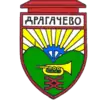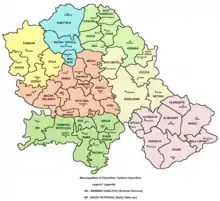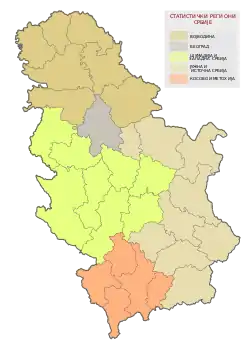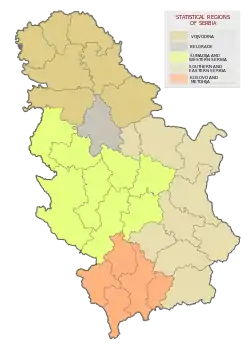Lučani
Lučani (Serbian Cyrillic: Лучани) is a town and municipality located in the Moravica District of western Serbia. The population of the town is 5,142, while the population of the municipality is 20,897.
Lučani
Лучани | |
|---|---|
Town and municipality | |
 Town Hall Entrance | |
 Coat of arms | |
 Location of the municipality of Lučani within Serbia | |
| Coordinates: 43°52′N 20°08′E | |
| Country | |
| Region | Šumadija and Western Serbia |
| District | Moravica |
| Settlements | 36 |
| Government | |
| • Mayor | Milivoje Dolović (SNS) |
| Area | |
| Area rank | 74th in Serbia |
| • Town | 1.99 km2 (0.77 sq mi) |
| • Municipality | 454.76 km2 (175.58 sq mi) |
| Elevation | 308 m (1,010 ft) |
| Highest elevation | 420 m (1,380 ft) |
| Lowest elevation | 293 m (961 ft) |
| Population (2011 census)[2] | |
| • Rank | 77th in Serbia |
| • Town | 5,142 |
| • Town density | 2,600/km2 (6,700/sq mi) |
| • Municipality | 20,897 |
| • Municipality density | 46/km2 (120/sq mi) |
| Time zone | UTC+1 (CET) |
| • Summer (DST) | UTC+2 (CEST) |
| Postal code | 32240 |
| Area code | +381(0)32 |
| Car plates | LU |
| Website | www |
Settlements
Aside from the town of Lučani, the municipality includes the following settlements:
- Beli Kamen
- Viča
- Vlasteljice
- Vučkovica
- Goračići
- Gornja Kravarica
- Gornji Dubac
- Grab
- Guberevci
- Guča
- Guča village
- Dljin
- Donja Kravarica
- Donji Dubac
- Dučalovići
- Đerađ
- Živica
- Zeoke
- Kaona
- Kotraža
- Krivača
- Krstac
- Lis
- Lisice
- Lučani village
- Markovica
- Milatovići
- Negrišori
- Puhovo
- Pšanik
- Rogača
- Rtari
- Rti
- Tijanje
- Turica
Demographics
| Year | Pop. | ±% p.a. |
|---|---|---|
| 1948 | 32,333 | — |
| 1953 | 34,412 | +1.25% |
| 1961 | 33,336 | −0.40% |
| 1971 | 31,646 | −0.52% |
| 1981 | 29,708 | −0.63% |
| 1991 | 27,167 | −0.89% |
| 2002 | 24,614 | −0.89% |
| 2011 | 20,897 | −1.80% |
| Source: [3] | ||
In the town of Lučani there are 5,142 inhabitants, while the average age of the population is 38,3 years (37,8 with men and 38,7 with women). There are 7,298 homes in the municipality and the average number of people living together is 2,86.
Ethnic groups
The municipality is largely inhabited by Serbs (97.9%).
|
|
Economy
Lučani is home to the chemical defence company Milan Blagojević - Namenska which employs around 1,300 people (as of 2017). Also, Maxima color manufacturer has its factory in Lučani.
The following table gives a preview of total number of registered people employed in legal entities per their core activity (as of 2018):[4]
| Activity | Total |
|---|---|
| Agriculture, forestry and fishing | 34 |
| Mining and quarrying | 6 |
| Manufacturing | 2,288 |
| Electricity, gas, steam and air conditioning supply | 187 |
| Water supply; sewerage, waste management and remediation activities | 58 |
| Construction | 82 |
| Wholesale and retail trade, repair of motor vehicles and motorcycles | 396 |
| Transportation and storage | 217 |
| Accommodation and food services | 151 |
| Information and communication | 12 |
| Financial and insurance activities | 25 |
| Real estate activities | - |
| Professional, scientific and technical activities | 99 |
| Administrative and support service activities | 31 |
| Public administration and defense; compulsory social security | 172 |
| Education | 294 |
| Human health and social work activities | 185 |
| Arts, entertainment and recreation | 71 |
| Other service activities | 51 |
| Individual agricultural workers | 391 |
| Total | 4,749 |
Sports
Lučani is home to the professional football club FK Mladost Lučani, which has played continuously in the Serbian SuperLiga, the top division of Serbian football.
Notable people
- Radmila Bakočević (b. 1933), opera singer
- Ratko Dostanić (b. 1959), football coach
- Boban Janković (1963–2006), basketball player
- Željko Tanasković (b. 1967), volleyball player
- Radojica Vasić (b. 1976), football player
- MC Stojan (b. 1983), singer
- Milan Bojović (b. 1987), football player
See also
References
- "Municipalities of Serbia, 2006". Statistical Office of Serbia. Retrieved 2010-11-28.
- "2011 Census of Population, Households and Dwellings in the Republic of Serbia: Comparative Overview of the Number of Population in 1948, 1953, 1961, 1971, 1981, 1991, 2002 and 2011, Data by settlements" (PDF). Statistical Office of Republic Of Serbia, Belgrade. 2014. ISBN 978-86-6161-109-4. Retrieved 2014-06-27.
- "2011 Census of Population, Households and Dwellings in the Republic of Serbia" (PDF). stat.gov.rs. Statistical Office of the Republic of Serbia. Archived from the original (PDF) on 14 July 2014. Retrieved 11 January 2017.
- "MUNICIPALITIES AND REGIONS OF THE REPUBLIC OF SERBIA, 2019" (PDF). stat.gov.rs. Statistical Office of the Republic of Serbia. 25 December 2019. Retrieved 25 December 2019.



